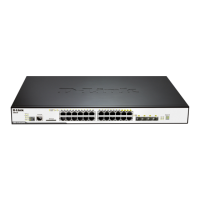xStack® DGS-3120 Series Layer 3 Managed Gigabit Ethernet Switch Web UI Reference Guide
104
Figure 4-36 STP Port Settings window
The fields that can be configured are described below:
Parameter Description
Select the unit you want to configure. (EI and SI Mode Only)
Select the starting and ending ports to be configured.
External Cost
(0=Auto)
This defines a metric that indicates the relative cost of forwarding packets to the
specified port list. Port cost can be set automatically or as a metric value. The default
value is 0 (auto). Setting 0 for the external cost will automatically set the speed for
forwarding packets to the specified port(s) in the list for optimal efficiency. The default
port cost for a 100Mbps port is 200000 and the default port cost for a Gigabit port is
20000. Enter a value between 1 and 200000000 to determine the External Cost. The
lower the number, the greater the probability the port will be chosen to forward
P2P Choosing the True parameter indicates a point-to-point (P2P) shared link. P2P ports
are similar to edge ports; however they are restricted in that a P2P port must operate
in full duplex. Like edge ports, P2P ports transition to a forwarding state rapidly thus
benefiting from RSTP. A P2P value of False indicates that the port cannot have P2P
status. Auto allows the port to have P2P status whenever possible and operate as if
the P2P status were True. If the port cannot maintain this status, (for example if the
port is forced to half-duplex operation) the P2P status changes to operate as if the
P2P value were False. The default setting for this parameter is Auto.
Restricted TCN
Topology Change Notification is a simple BPDU that a bridge sends out to its root
port to signal a topology change. Restricted TCN can be toggled between True and
False. If set to True, this stops the port from propagating received topology change
notifications and topology changes to other ports. The default is False.
Migrate When operating in RSTP mode, selecting Yes forces the port that has been selected
Port STP
This drop-down menu allows you to enable or disable STP for the selected group of
ports. The default is Enabled.
Forward BPDU
Use the drop-down menu to enable or disable the flooding of BPDU packets when

